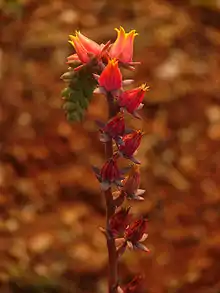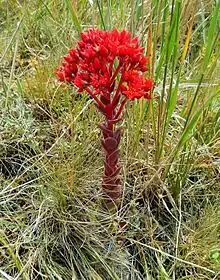| Rosularia | |
|---|---|
 | |
| Rosularia flowers | |
| Scientific classification | |
| Kingdom: | Plantae |
| Clade: | Tracheophytes |
| Clade: | Angiosperms |
| Clade: | Eudicots |
| Order: | Saxifragales |
| Family: | Crassulaceae |
| Subfamily: | Sempervivoideae |
| Tribe: | Sedeae |
| Genus: | Rosularia (DC) Stapf |
| Species | |
|
See text | |
| Synonyms | |
|
Sempervivella Stapf[1] | |

Rosularia is a small genus of the family Crassulaceae. It includes about 28-35 species from Europe, the Himalayas, and northern Africa.
Taxonomy
Rosularia was originally described by De Candolle (1828) as a section of the genus Umbilicus,[2] and raised to the level of genus by Stapf (1923)[3] Thus the genus bears the botanical authority (DC) Stapf of both authors.[1]
In 1930 Berger included it in family Crassulaceae subfamily Sedoideae, as one of 9 genera.[4][5] He further divided it into two sections (Eu-Rosularia and Ornithogalopsis) and further series,[6] transferring some species of Sedum to it. Since then a number of species have been transferred in and out of the genus, including S. sempervivoides, which at one stage was placed in Prometheum.[5] The genus Sempervivella was submerged in Rosularia.[6] The genus is now placed within the Leucosedum clade, tribe Sedeae, subfamily Sempervivoideae of the Crassulaceae, but is embedded within Sedum paraphyletically.[7][1][8]
Species
Rosularia contains about 28 species. The following species and subspecies were accepted by The Plant List (2013):[9][10]
- Rosularia adenotricha (Wall. ex Edgew.) C.-A. Jansson[11]
- Rosularia adenotricha subsp. viguieri (Raym.-Hamet) C.-A. Jansson
- Rosularia aizoon (Fenzl) A. Berger
- Rosularia alpestris (Kar. & Kir.) Boriss
- Rosularia alpestris subsp. marnieri(Raymond-Hamet ex H. Ohba) Eggli
- Rosularia blepharophylla Eggli
- Rosularia borissovae U.P.Pratov
- Rosularia chrysantha (Boiss. & Heldr. ex Boiss.) Takhtajan
- Rosularia cypria (Holmboe) Meikle
- Rosularia davisii Muirhead
- Rosularia elymaitica (Boiss. & Hausskn. ex Boiss.) A. Berger
- Rosularia glabra (Regel & Winkl.) A.Berger
- Rosularia globulariifolia (Fenzl) A. Berger
- Rosularia haussknechtii (Boiss. & Reut. ex Boiss.) A. Berger
- Rosularia jaccardiana (Maire & Wilczek) H. Ohba
- Rosularia libanotica (L.) Sam.
- Rosularia lineata (Boiss.) A.Berger
- Rosularia lutea Boriss.
- Rosularia pallida (Schott & Kotschy) Stapf
- Rosularia pallidiflora (Holmboe) Meikle
- Rosularia persica (Boiss.) A. Berger
- Rosularia pilosa (Fischer ex M. Bieberstein) Boriss.
- Rosularia platyphylla (Schrenk) A.Berger
- Rosularia radicosa (Boiss. & Hohen.) Eggli
- Rosularia rechingeri C.-A. Jansson
- Rosularia rosulata (Edgew.) H. Ohba
- Rosularia schischkinii Boriss.
- Rosularia sedoides (Decne.) H. Ohba
- Rosularia semiensis (J. Gay ex A. Richard) H. Ohba
- Rosularia sempervivoides (Fischer ex M. Bieberstein) Boriss.
- Rosularia serpentinica (Werderm.) Muirhead
- Rosularia serrata (L.) A.Berger
- Rosularia subspicata (Freyn) Boriss.
Distribution and habitat
Rosularia is found in arid and semi-arid regions from N. Africa (Morocco, Ethiopia), through the eastern Mediterranean to Central Asia (north of Tien Shan and east of W Himalaya), including Pakistan.[6][5]
Ecology
Rosularia is an important larval host for the Central Asian butterfly Parnassius apollonius.[12]
Uses
A number of species are cultivated as ornamental garden plants, and have been used in traditional medicine.[5]
References
Bibliography
- Books
- Berger, A. (1930). "Crassulacaeae". In Engler, Adolf; Prantl, Karl Anton (eds.). Die Natürlichen Pflanzenfamilien. Vol. 18A. Leipzig: Verlag von Wilhelm Engelmann. pp. 352–483.
- de Candolle, A. P. (1828). "Crassulaceae". Prodromus systematis naturalis regni vegetabilis, sive, Enumeratio contracta ordinum generum specierumque plantarum huc usque cognitarium, juxta methodi naturalis, normas digesta. Vol. 3. Paris: Treuttel et Würtz. pp. 381–414.
- Tuzov, V. K. (1997). Guide to the Butterflies of Russia and Adjacent Territories: Vol. 1 Hesperiidae, Papilionidae, Pieridae, Satyridae. Coronet Books Incorporated. ISBN 978-954-642-018-3.
- Thiede, J; Eggli, U (2007). "Crassulaceae". In Kubitzki, Klaus (ed.). Berberidopsidales, Buxales, Crossosomatales, Fabales p.p., Geraniales, Gunnerales, Myrtales p.p., Proteales, Saxifragales, Vitales, Zygophyllales, Clusiaceae Alliance, Passifloraceae Alliance, Dilleniaceae, Huaceae, Picramniaceae, Sabiaceae. Springer. pp. 83–119. ISBN 978-3540322146. (full text at ResearchGate)
- Articles
- Mayuzumi, Shinzo; Ohba, Hideaki (2004). "The Phylogenetic Position of Eastern Asian Sedoideae (Crassulaceae) Inferred from Chloroplast and Nuclear DNA Sequences". Systematic Botany. 29 (3): 587–598. doi:10.1600/0363644041744329. ISSN 0363-6445. JSTOR 25063994. S2CID 84319808.
- Ohba, H (1978). "Generic and infrageneric classification of the old world sedoideae crassulaceae". Journal of the Faculty of Science University of Tokyo Section III Botany 12(4): 139-193. 12 (4): 139–193.
- Sarwar, Ghulam Rasool; Qaiser, Muhammad (2012). "A numerical taxonomy of the genus Rosularia (DC.) Stapf from Pakistan and Kashmir" (PDF). Pak. J. Bot. 44 (1): 349–354. S2CID 32097729. Archived from the original (PDF) on 2019-10-01.
- Stapf, Otto (1923). "Sempervivella alba". Curtis's Botanical Magazine. 149: 1–4.
- Websites
- TPL (2013). "The Plant List Version 1.1: Rosularia". Royal Botanic Gardens, Kew and Missouri Botanical Garden. Retrieved 1 October 2019.
- WFO (2019). "Rosularia (DC.) Stapf". World Flora Online. Retrieved 1 September 2019.
- "Tropicos". Missouri Botanical Garden. 2019. Retrieved 1 October 2019.
- "Rosularia adenotricha". Royal Horticultural Society. 2019. Retrieved 1 October 2019.